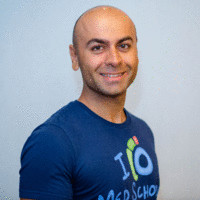No industry has been spared massive disruption from the coronavirus pandemic and resulting rapid digitalization. But for both higher education and healthcare, disruption had already been a way of life—just on a more gradual scale. The pandemic has further driven down college enrollment numbers that were already on a decade-long decline, leaving many institutions in unprecedented financial distress. Meanwhile, healthcare providers are being pushed to simultaneously deliver higher quality care at a lower cost.

For university leaders, medical education presents an ideal opportunity to address current gaps in enrollment, while also positioning the institution to meet future demands. Not only are we experiencing greater demand for healthcare workers (indeed, six of the fastest 10 growing professions in the U.S. are in healthcare), but the growth of emerging fields like advanced technology, population health, and care coordination means traditional medical schools are not adequately equipped to address current needs.
Expanding healthcare education certificate and degree programs enables universities to get more students in the door today while positioning them for long-term stability through massive transformation. But it involves rethinking the traditional approach.
Increasing demands for medical education
Since 2002, the Association of American Medical Colleges (AAMC) has reported a 31% growth in enrollment at medical schools. It’s no wonder—healthcare is where graduates will find jobs today and tomorrow. The U.S. population is growing older and sicker, with comorbidities like heart disease and diabetes on the rise. At the same time, 33% of working nurses will reach retirement age in the next 8 years. And though the nursing shortage is the most egregious, by 2030, we can expect to see a worldwide shortage of 15 million healthcare workers as the demand for jobs across health systems will likely double.
According to the U.S. Bureau of Labor Statistics, healthcare jobs are expected to grow at a faster pace than any other industry—up 14% from 2018 to 2028. These jobs appeal to a diverse population of students, too, offering a variety of entry points, educational requirements and salary expectations. A surgical technician could meet job qualifications in a shorter period of time and still expect to earn $48,000 while a nurse pursuing a RN degree will enter a labor market with a median salary of $73,000, according to the U.S. Department of Labor.
But traditional higher education is simply not equipped to handle the surge of people pursuing degrees in healthcare. Over the last ten years, the number of people applying to medical school has increased by 25%, but there are not enough openings at medical schools to accommodate them. Today’s social distancing guidelines in classrooms and residency programs add further strain.
So how can universities adapt to address this opportune gap?
Integrating traditional and digital learning in medical education
Closing the gap in high-quality medical education is not as simple as launching new degree programs. Just as there are shortages of healthcare workers and medical education spots to train applicants, there are also not enough instructors to meet the demand. And with expansive real estate footprints becoming burdensome when competing with hybrid and online campuses, universities must get creative to maximize their human and real estate capital. The key is to integrate traditional and digital learning techniques.
Digital tools like educational videos and experiential recordings can supplement an instructor’s knowledge as well as spotlight the latest advances—no matter where they occur. Additionally, as emerging fields grow in popularity, supplemental digital tools provide universities with greater flexibility to apply content to various specialties and learning paths. And considering the speed of technological advancements, relying solely on traditional in-person instruction sets students and institutions behind.
Given that not all healthcare education can be done virtually, it’s important that there be physical spaces where trainees can meet standardized patients as well as practice on simulated cases and mannequins. As traditional college buildings empty, many of these spaces can be repurposed to provide healthcare training and potentially even basic healthcare to the communities they serve.
Digital content also gives students greater control over their education, enabling them to more extensively pursue topics that interest them the most. Plus, as more people pursue their education while working, for example, a registered nurse studying to become a nurse practitioner, the demand for flexibility in content delivery will only increase.
On-demand content delivery is here to stay and the need for additional medical education will only continue to grow. Combining these two trends presents an ideal opportunity for universities seeking new ways to increase enrollment and strengthen their foundation for the future.
Shiv Gaglani is the co-founder and chief executive officer of Osmosis.org, a health education platform with an audience of current and future clinicians as well as their patients and family members. Gaglani’s primary passion is developing innovative and scalable solutions in the fields of healthcare and education. To this end he curated the Smartphone Physical, which debuted at TEDMED, and the Patient Promise, a movement to improve clinician-patient relationship through partnership in pursuing healthy lifestyle behaviors.

